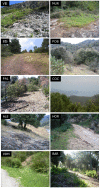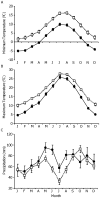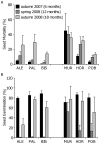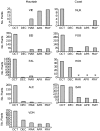Demographic and genetic patterns of variation among populations of Arabidopsis thaliana from contrasting native environments
- PMID: 19787050
- PMCID: PMC2746291
- DOI: 10.1371/journal.pone.0007213
Demographic and genetic patterns of variation among populations of Arabidopsis thaliana from contrasting native environments
Abstract
Background: Understanding the relationship between environment and genetics requires the integration of knowledge on the demographic behavior of natural populations. However, the demographic performance and genetic composition of Arabidopsis thaliana populations in the species' native environments remain largely uncharacterized. This information, in combination with the advances on the study of gene function, will improve our understanding on the genetic mechanisms underlying adaptive evolution in A. thaliana.
Methodology/principal findings: We report the extent of environmental, demographic, and genetic variation among 10 A. thaliana populations from Mediterranean (coastal) and Pyrenean (montane) native environments in northeast Spain. Geographic, climatic, landscape, and soil data were compared. Demographic traits, including the dynamics of the soil seed bank and the attributes of aboveground individuals followed over a complete season, were also analyzed. Genetic data based on genome-wide SNP markers were used to describe genetic diversity, differentiation, and structure. Coastal and montane populations significantly differed in terms of environmental, demographic, and genetic characteristics. Montane populations, at higher altitude and farther from the sea, are exposed to colder winters and prolonged spring moisture compared to coastal populations. Montane populations showed stronger secondary seed dormancy, higher seedling/juvenile mortality in winter, and initiated flowering later than coastal populations. Montane and coastal regions were genetically differentiated, montane populations bearing lower genetic diversity than coastal ones. No significant isolation-by-distance pattern and no shared multilocus genotypes among populations were detected.
Conclusions/significance: Between-region variation in climatic patterns can account for differences in demographic traits, such as secondary seed dormancy, plant mortality, and recruitment, between coastal and montane A. thaliana populations. In addition, differences in plant mortality can partly account for differences in the genetic composition of coastal and montane populations. This study shows how the interplay between variation in environmental, demographic, and genetic parameters may operate in natural A. thaliana populations.
Conflict of interest statement
Figures





Similar articles
-
Temporal variation in genetic diversity and effective population size of Mediterranean and subalpine Arabidopsis thaliana populations.Mol Ecol. 2011 Sep;20(17):3540-54. doi: 10.1111/j.1365-294X.2011.05193.x. Epub 2011 Jul 25. Mol Ecol. 2011. PMID: 21790818
-
Genomic and phenotypic differentiation of Arabidopsis thaliana along altitudinal gradients in the North Italian Alps.Mol Ecol. 2016 Aug;25(15):3574-92. doi: 10.1111/mec.13705. Epub 2016 Jul 2. Mol Ecol. 2016. PMID: 27220345
-
Genetic variation, environment and demography intersect to shape Arabidopsis defense metabolite variation across Europe.Elife. 2021 May 5;10:e67784. doi: 10.7554/eLife.67784. Elife. 2021. PMID: 33949309 Free PMC article.
-
Archaic lineages broaden our view on the history of Arabidopsis thaliana.New Phytol. 2018 Sep;219(4):1194-1198. doi: 10.1111/nph.15244. Epub 2018 Jun 4. New Phytol. 2018. PMID: 29862511 Review.
-
Genetic mechanisms and evolutionary significance of natural variation in Arabidopsis.Nature. 2006 Jun 22;441(7096):947-52. doi: 10.1038/nature04878. Nature. 2006. PMID: 16791187 Review.
Cited by
-
An integrative Study Showing the Adaptation to Sub-Optimal Growth Conditions of Natural Populations of Arabidopsis thaliana: A Focus on Cell Wall Changes.Cells. 2020 Oct 7;9(10):2249. doi: 10.3390/cells9102249. Cells. 2020. PMID: 33036444 Free PMC article.
-
A Single Nucleotide Deletion in Gibberellin20-oxidase1 Causes Alpine Dwarfism in Arabidopsis.Plant Physiol. 2015 Jul;168(3):930-7. doi: 10.1104/pp.15.00005. Epub 2015 May 4. Plant Physiol. 2015. PMID: 25941313 Free PMC article.
-
Evaluating the Roles of Drift and Selection in Trait Loss along an Elevational Gradient.bioRxiv [Preprint]. 2024 Nov 18:2024.06.12.598645. doi: 10.1101/2024.06.12.598645. bioRxiv. 2024. Update in: Evolution. 2025 Jul 18;79(7):1322-1333. doi: 10.1093/evolut/qpaf078. PMID: 38915635 Free PMC article. Updated. Preprint.
-
Temporal migration rates affect the genetic structure of populations in the biennial Erysimum mediohispanicum with reproductive asynchrony.AoB Plants. 2020 Jul 25;12(4):plaa037. doi: 10.1093/aobpla/plaa037. eCollection 2020 Aug. AoB Plants. 2020. PMID: 32904355 Free PMC article.
-
Structure of multilocus genetic diversity in predominantly selfing populations.Heredity (Edinb). 2019 Aug;123(2):176-191. doi: 10.1038/s41437-019-0182-6. Epub 2019 Jan 22. Heredity (Edinb). 2019. PMID: 30670844 Free PMC article.
References
-
- Feder ME, Mitchell-Olds T. Evolutionary and ecological functional genomics. Nat Rev Genet. 2003;4:649–655. - PubMed
-
- Alonso-Blanco C, Méndez-Vigo B, Koornneef M. From phenotypic to molecular polymorphisms involved in naturally occurring variation of plant development. Int J Dev Biol. 2005;49:717–732. - PubMed
-
- Tonsor SJ, Alonso-Blanco C, Koornneef M. Gene function beyond the single trait: natural variation, gene effects, and evolutionary ecology in Arabidopsis thaliana. Plant Cell Environ. 2005;28:2–20.
-
- Mitchell-Olds T, Schmitt J. Genetic mechanisms and evolutionary significance of natural variation in Arabidopsis. Nature. 2006;441:947–952. - PubMed
-
- Mitchell-Olds T, Feder M, Wray G. Evolutionary and ecological functional genomics. Heredity. 2008;100:101–102. - PubMed

